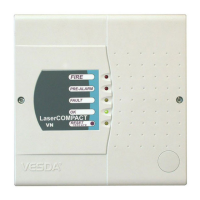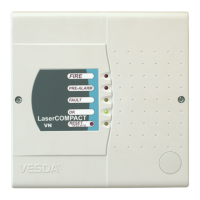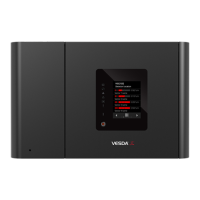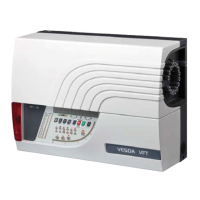VESDA by Xtralis VESDA Pipe Network Installation Guide
www.xtralis.com 19
5.1.3 Floor Void Installation
Installations in the under floor void require considerations similar to the In-Ceiling Void Installation.
Figure 5-3: Typical under floor installation
The Guidelines to be followed for Floor Void Installations include:
1. Refer to the guidelines for In-ceiling installations for general guidelines.
2. Supporting posts can be used to secure the pipe.
3. As the initial smoke layer normally takes up the top 10% of the void height, pipes should be placed as
close to the floor as possible.
4. Secure the pipe using appropriate conduit clamps or self locking ties ensuring that the distance
between the floor and the pipe is according to the design specification. For further information, refer to
Section 3.9 on page 10.
5.1.4 Inter-beam
Inter-beam sampling is used in areas having large beams as defined by local fire code and standards, or as per
site requirements. Design documents will specify the requirement for inter-beam sampling.
The three methods for inter-beam sampling are:
Sampling Pipe Traversing inside of the Beam Pocket - Bend the sampling pipe, where the depth of the
beam allows the pipe to be bent without it cracking or crinkling (refer to Section 4.5 on page 15).
Legend
A Sampling Pipe
B Beam Pockets
C Sampling holes
Figure 5-4: Inter-beam sampling using pipe bends
Walking Sticks - Walking sticks are attached to the sampling pipe. The walking stick is a length of riser pipe.
Attach a bend or an elbow at the top end of the riser pipe. Fix an appropriate length of pipe to the bend or elbow
and drill a sampling hole (as specified in the design documents) into the pipe. Close the end of the pipe with an
end cap. Attach the walking stick to a Tee adaptor using a reducing connector (if required). Join the Tee to the
sampling pipe at the specified spot.
Legend
A Sampling Pipe
B Beam Pockets
C Sampling holes
Figure 5-5: Inter-beam sampling using a walking stick
Underside of the Beams - Run the sampling pipe with sampling holes facing down, along the underside of
the beams.
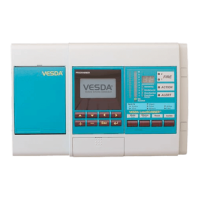
